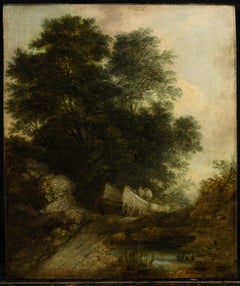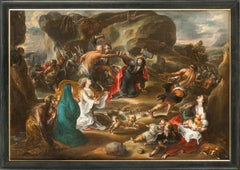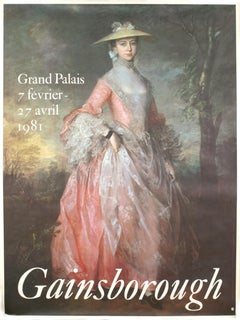Thomas Gainsborough Art
English, 1727-1788
Known for his portraits, Gainsborough himself considered himself primarily a landscape painter. But landscapes were not marketable in England at the time, and the artist's main income came from portraits. Nevertheless, in Gainsborough's work, landscape plays no less of a role than portraits, both in quality and quantity. The practice of creating small landscapes as an attempt to look through and see the overall pattern and intent became his preferred method of working.
In addition, Gainsborough often turned to the works of seventeenth-century Dutch landscape painters for inspiration. With the study of the Old Masters, Gainsborough's landscapes developed an emphasis on the background. The glittering dales, highlighted by light and beckoning to the viewer, give the landscapes of the mature period depth. Gainsborough skillfully combined the realism of the Dutch landscape with the lightness and decorativeness of the French one. The artist's style of painting became increasingly broad and free, and the color layer more fluid.
Gainsborough drew inspiration for this work from a painting attributed to Peter Molyneux (1595 - 1661) and, of course, the painting present seems to have been based on the work, an artist whose work appeared whose work was in Gainsborough's personal collection2. Massive trees dominate the left side of the composition, opening to the right. In the landscape painted for the exhibition, Gainsborough filled both sides and the entire top of the canvas with depictions of tree crowns, balancing both parts of the composition and echoing the somber majesty of Jacob van Reisdal's landscapes3. The changeable play of light and shadow in the dense foliage is given a dramatic quality that is offset by the overall lyrical mood of the landscape. The lightness of the brush and the freedom of the painterly manner shades the compositional clarity. The main role here is played by light. It, for the first time, begins to play a constructive role. The landscape is permeated with light, but the light is not bright, the scattered light of the English sky.
It is light that is the main innovation of Gainsborough in the field of landscape, which opened the way to its further development up to Romanticism and the paintings of John Constable, an admirer of Gainsborough's work.(Biography provided by Rain Art OÜ)
to
2
2
2
Portrait of Vice Admiral Sir Thomas Brodrick by Thomas Gainsborough 1727-1788
By Thomas Gainsborough
Located in Lincoln, GB
Thomas Gainsborough 1727-1788
Portrait of Vice Admiral Sir Thomas Brodrick
Oil on Canvas
75cms x 61cms
Framed
Category
18th Century Thomas Gainsborough Art
Materials
Oil
Wooded Landscape with Peasants in a Wagon
By Thomas Gainsborough
Located in Tallinn, EE
Thomas Gainsborough R.A.
(1727, Sudbury - 1788, London)
Wooded Landscape with Peasants in a Wagon
oil on panel
35,5 by 29,8 cm.
Provenance
Charles, Viscount Eversley (1794-1888); B...
Category
18th Century Thomas Gainsborough Art
Materials
Canvas, Oil
Related Items
Christ Carrying the Cross, Old Master, Flemish, De Vos, Religious Scene, Rubens
By Simon de Vos
Located in Greven, DE
The scene of Christ carrying the cross is imagined in a rocky landscape. Two soldiers press the cross onto his shoulders, another leads him, holding the rope. A line of soldiers and prisoners moves from right to left. In front of them the three Marys kneel and pray for Christ. A nursing woman, symbol of Caritas, sits in the right foreground. Some dogs and playing kids enliven the scenery.
Simon de Vos was born in Antwerp, and was first taught by Cornelis de Vos...
Category
17th Century Baroque Thomas Gainsborough Art
Materials
Canvas, Oil
Free Shipping
H 23.04 in W 33.27 in
Continence of Scipio, Erasmus Quellinus, School Rubens, Baroque Art, Old Master
By Erasmus Quellinus the Younger
Located in Greven, DE
Erasmus Quellinus
The Continence of Scipio
Oil on Canvas
The painting is included in the Catalogue Raisonné of the artist.
The Roman commande...
Category
17th Century Baroque Thomas Gainsborough Art
Materials
Oil, Canvas
Free Shipping
H 42.52 in W 64.18 in
The Veronica of the Virgin (Verónica de la Virgen)
Located in New York, NY
The panel has been attributed both to Joan de Joanes and his son Vicente Macip Comes (Valencia, ca. 1555 – 1623).
Provenance:
Private Collection, England, by 1886 (according to stencils on the reverse)
Private Collection, New Jersey, until 2010
The Veil of Veronica, often called the Sudarium, is one of the most important and well-known relics of Christ. According to legend, Veronica offered Christ her veil as he carried the cross to his crucifixion. He wiped his face with the veil, which left the cloth miraculously imprinted with his image. Depictions of Christ’s face on a veil, or simply images that focused in on Christ’s face, were treasured objects of religious devotion. The popularity of this format also inspired similar images of the face of the Virgin.
The iconographic type of the present painting is known as the Veronica of the Virgin, which was especially favored in late medieval and early Renaissance Spain. Distinct from the images of the suffering Christ, the Veronica of the Virgin is based on the legend that Saint Luke painted a portrait of Mary from life. Although scholars have sometimes mistaken them for portraits of Queen Isabella I of Castile (known as Isabel la Católica) or as a depiction of Saint Maria Toribia (known as María de la Cabeza, or, Mary of the Head), paintings like this one were clearly intended as images of the Virgin in the style of Saint Luke’s lost portrait.
The Veronica of the Virgin was especially popular in Valencia, and depictions of this subject produced there all stem back to one visual prototype: a Byzantine image in the city’s cathedral (Fig. 1). This early treatment of the Veronica was given to the cathedral in 1437 by Martin the Humane, King of Aragon and Valencia, who promoted religious veneration of the Veronica of the Virgin as part of the celebration of the Immaculate Conception of Mary. This devotion spread throughout Martin’s kingdom and particularly took hold in Valencia, where the Byzantine image resided. The image, which is displayed in a gold reliquary...
Category
16th Century Old Masters Thomas Gainsborough Art
Materials
Oil, Wood Panel
Portrait of a Gentleman
Located in New York, NY
Circle of Jacques-Louis David
(French, 18th Century)
Provenance:
Private Collection, Buenos Aires
Exhibited:
“Art of Collecting,” Flint Institute of Art, Flint, Michigan, 23 November 2018 – 6 January 2019.
This vibrant portrait of young man was traditionally considered a work by Jacques-Louis David, whose style it recalls, but to whom it cannot be convincingly attributed. Rather, it would appear to be by a painter in his immediate following—an artist likely working in France in the first decade of the nineteenth century. Several names have been proposed as the portrait’s author: François Gérard, Louis Hersent, Anne-Louis Girodet (Fig. 1), Theodore Gericault, and Jean-Baptiste Wicar, among others. Some have thought the artist Italian, and have proposed Andrea Appiani, Gaspare Landi...
Category
18th Century Old Masters Thomas Gainsborough Art
Materials
Canvas, Oil
Temple of Paestum, Max Usadel (ca. 1880-1950), 1912, Oil Paint on Canvas
Located in Greding, DE
Max Usadel (ca.1880-1950), Temple of Paestum, dat. 1912
View of the temple of Paestum with two ox carts in the foreground. The setting sun creates a dramati...
Category
1910s Impressionist Thomas Gainsborough Art
Materials
Canvas, Oil
H 37.41 in W 52.37 in D 1.19 in
Portrait of a Lady with a Chiqueador
Located in New York, NY
Provenance: Torres Family Collection, Asunción, Paraguay, ca. 1967-2017
While the genre of portraiture flourished in the New World, very few examples of early Spanish colonial portraits have survived to the present day. This remarkable painting is a rare example of female portraiture, depicting a member of the highest echelons of society in Cuzco during the last quarter of the 17th century. Its most distinctive feature is the false beauty mark (called a chiqueador) that the sitter wears on her left temple. Chiqueadores served both a cosmetic and medicinal function. In addition to beautifying their wearers, these silk or velvet pouches often contained medicinal herbs thought to cure headaches.
This painting depicts an unidentified lady from the Creole elite in Cuzco. Her formal posture and black costume are both typical of the established conventions of period portraiture and in line with the severe fashion of the Spanish court under the reign of Charles II, which remained current until the 18th century. She is shown in three-quarter profile, her long braids tied with soft pink bows and decorated with quatrefoil flowers, likely made of silver. Her facial features are idealized and rendered with great subtly, particularly in the rosy cheeks.
While this portrait lacks the conventional coat of arms or cartouche that identifies the sitter, her high status is made clear by the wealth of jewels and luxury materials present in the painting. She is placed in an interior, set off against the red velvet curtain tied in the middle with a knot on her right, and the table covered with gold-trimmed red velvet cloth at the left. The sitter wears a four-tier pearl necklace with a knot in the center with matching three-tiered pearl bracelets and a cross-shaped earing with three increasingly large pearls. She also has several gold and silver rings on both hands—one holds a pair of silver gloves with red lining and the other is posed on a golden metal box, possibly a jewelry box. The materials of her costume are also of the highest quality, particularly the white lace trim of her wide neckline and circular cuffs.
The historical moment in which this painting was produced was particularly rich in commissions of this kind. Following his arrival in Cuzco from Spain in the early 1670’s, bishop Manuel de Mollinedo y Angulo actively promoted the emergence of a distinctive regional school of painting in the city. Additionally, with the increase of wealth and economic prosperity in the New World, portraits quickly became a way for the growing elite class to celebrate their place in society and to preserve their memory. Portraits like this one would have been prominently displayed in a family’s home, perhaps in a dynastic portrait gallery.
We are grateful to Professor Luis Eduardo Wuffarden for his assistance cataloguing this painting on the basis of high-resolution images. He has written that “the sober palette of the canvas, the quality of the pigments, the degree of aging, and the craquelure pattern on the painting layer confirm it to be an authentic and representative work of the Cuzco school of painting...
Category
17th Century Old Masters Thomas Gainsborough Art
Materials
Canvas, Oil
H 66.25 in W 43.75 in
Portrait of a Man
Located in New York, NY
Provenance:
with Leo Blumenreich and Julius Böhler, Munich, 1924
Dr. Frederic Goldstein Oppenheimer (1881-1963), San Antonio, Texas; by whom given to:
Abraham M. Adler, New York, un...
Category
16th Century Old Masters Thomas Gainsborough Art
Materials
Oil, Panel
Saint Martin de Porres
Located in New York, NY
Provenance: Private Collection, New York, until 2022.
Martín de Porres was born in Lima in 1579, the illegitimate son of a Spanish-American father, J...
Category
Late 18th Century Thomas Gainsborough Art
Materials
Canvas, Oil
Madonna and Child with Angels in the Clouds
Located in New York, NY
Provenance: Charles H. and Virginia Baldwin, Claremont, Colorado Springs, Colorado ca. 1907-1934; thence by descent until sold in 1949 to:
Charles Blevins Davis, Claremont (renamed Trianon), Colorado Springs 1949 -until gifted in 1952 to:
The Poor Sisters of Saint Francis, Trianon, Colorado Springs, 1952 until acquired, 1960, by:
John W. Metzger, Trianon, renamed as the Trianon School of Fine Arts, Colorado Springs, 1960-1967; when transferred to:
The Metzger Family Foundation, Trianon Art Museum, Denver, 1967 - 2004; thence by descent in the Metzger Family until 2015
Exhibited: Trianon Art Museum, Denver (until 2004)
The present work is a spectacular jewel-like canvas by Amigoni, rich in delicate pastel colors, most likely a modello for an altarpiece either lost or never painted. In it the Madonna stands firmly upon a cloud in the heavens, her Child resting on a delicate veil further supported by a cloud, as he gently wraps his arm around his mother’s neck. From above angels prepare to lower flowers and a wreath, while other angels and seraphim surrounding the two joyfully cavort.
Dr. Annalisa Scarpa, author of the forthcoming monograph on Jacopo Amigoni...
Category
18th Century and Earlier Thomas Gainsborough Art
Materials
Canvas, Oil
View of Ponte Milvio in Rome
Located in Roma, RM
Northern painter active in Rome in the second half of the 17th century, View of Ponte Milvio
Oil painting on canvas 73 x 97 cm in coeval Roman Salvator Rosa frame.
Category
18th Century and Earlier Old Masters Thomas Gainsborough Art
Materials
Canvas, Oil
Van der Bent, Southern Landscape with woman animals, Dutch Old Master, Berchem
Located in Greven, DE
17th Century Old Master, Figurative and Landscape Painting by Jan Van der Bent
So far, little is known about the life and work of Jan van der Bent. He was...
Category
17th Century Baroque Thomas Gainsborough Art
Materials
Canvas, Oil
Alpine lake
Located in Roma, RM
Emilio Longoni (Barlassina 1859 - Milan 1932), Alpine Lake (1910)
Oil painting on canvas pasted on board 20 x 41 cm signed lower right in Emilian frame late 16th century.
Category
Early 20th Century Pointillist Thomas Gainsborough Art
Materials
Canvas, Oil, Board
Previously Available Items
Thomas Gainsborough-Grand Palais-63" x 47.5"-Poster-1981-Impressionism
By Thomas Gainsborough
Located in Brooklyn, NY
Billboard size poster by Gainsborough from an exhibition held at the Grand Palais in Paris in 1981.
Category
20th Century Thomas Gainsborough Art
Materials
Offset
Portrait of the Rev. Richard Harris of Wymering Manor (1711-1768)
By Thomas Gainsborough
Located in London, GB
THOMAS GAINSBOROUGH (1727-1788)
Portrait of the Rev. Richard Harris of Wymering Manor (1711-1768)
Oil on canvas
30 x 25 in. (76 x 63.5 cm)
37 x 32 inche...
Category
18th Century Old Masters Thomas Gainsborough Art
Materials
Oil
Kirk Alloway
By Thomas Gainsborough
Located in Saint Augustine, FL
An original etching on wove paper after English artist Thomas Gainsborough (1727-1788) titled "Kirk Alloway" c. 1875. Frame ready: shrink wrapped and matting from Holland. Matted size: 20.25" x 16.5". Image size: 3.25" x 5". Mint condition.
Thomas Gainsborough, (christened 14 May 1727 – 2 August 1788), was an English portrait and landscape painter. He left home in 1740 to study art in London with Hubert Gravelot, Francis Hayman, and William Hogarth. In 1746, he married Margaret Burr, and they became parents of two daughters. He moved to Bath in 1759 where fashionable society patronised him, and he began exhibiting in London. In 1769, he became a founding member of the Royal Academy, but his relationship with the organization was thorny and he sometimes withdrew his work from exhibition. Gainsborough moved to London in 1774, and painted portraits of the king and queen, but the king was obliged to name as royal painter Gainsborough's rival Joshua Reynolds. In his last years, Gainsborough painted relatively simple landscapes and is credited (with Richard Wilson) as the originator of the 18th century British landscape...
Category
1870s Victorian Thomas Gainsborough Art
Materials
Etching
Ellis Island
By Thomas Gainsborough
Located in Saint Augustine, FL
An original etching on wove paper after English artist Thomas Gainsborough (1727-1788) titled "Ellis Island" c. 1875. Frame ready: shrink wrapped and matting from Holland. Matted size: 20.25" x 16.5". Image size: 3.25" x 5". Mint condition.
Thomas Gainsborough, (christened 14 May 1727 – 2 August 1788), was an English portrait and landscape painter. He left home in 1740 to study art in London with Hubert Gravelot, Francis Hayman, and William Hogarth. In 1746, he married Margaret Burr, and they became parents of two daughters. He moved to Bath in 1759 where fashionable society patronised him, and he began exhibiting in London. In 1769, he became a founding member of the Royal Academy, but his relationship with the organization was thorny and he sometimes withdrew his work from exhibition. Gainsborough moved to London in 1774, and painted portraits of the king and queen, but the king was obliged to name as royal painter Gainsborough's rival Joshua Reynolds. In his last years, Gainsborough painted relatively simple landscapes and is credited (with Richard Wilson) as the originator of the 18th century British landscape...
Category
1870s Victorian Thomas Gainsborough Art
Materials
Etching
Thomas Gainsborough art for sale on 1stDibs.
Find a wide variety of authentic Thomas Gainsborough art available for sale on 1stDibs. You can also browse by medium to find art by Thomas Gainsborough in oil paint, paint, canvas and more. Not every interior allows for large Thomas Gainsborough art, so small editions measuring 12 inches across are available. Customers who are interested in this artist might also find the work of George Morland, William Edward Frost, and Benjamin Williams Leader. Thomas Gainsborough art prices can differ depending upon medium, time period and other attributes. On 1stDibs, the price for these items starts at $57,336 and tops out at $57,336, while the average work can sell for $57,336.




